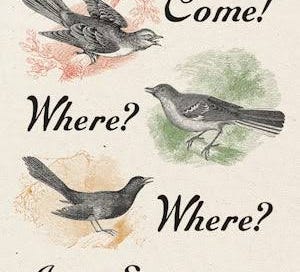Book Review: Come! Come! Where? Where?- Essays by James Seay
Life is not what one lived, but what one remembers and how one remembers in order to recount it. - Marquez
When I read the collection of essays by James Seay, an established American poet, titled Come! Come! Where? Where? I remembered the words by Marquez that I quoted at the top. Seay, in one of his pieces, writes about the exaggerations that he made to the memories of his mother, so that her story became more mysterious and elusive to him. I am all for taking such liberties with memories; after all, it's his mother and his memories about her that he's writing about. Who are we to demand historical accuracy from them?
The collection, published by The University of North Carolina Press, who were gracious enough to provide me with this review copy through Netgalley, consists of twenty essays of varying length about diverse topics. All these essays are birthed by the experiences of the writer, from his childhood, his multiple professions, and his interactions with people at various places that he visited and stayed in his life. The author tries to find takeaways from each of them that he feels are deserving of being shared with his readers. When we look into the past, we remember only snippets of some memories, most of them so vague that it becomes an impossibility to reconstruct them. But there may be some vivid frames that we never forget and that continue to grow inside us, making our lives richer.
Many essays in this collection pick up these snippets and present them to the reader after polishing and embellishing. The writer tries to find universality in everyday experiences and inspires the readers to also look out for aspects of our daily lives that could make them richer and worthier. Now, when I claim that this is the writer's intention, I would also agree that not all twenty essays achieve this evenly.
There are some essays, like the one that deals with the author's journey connecting Faulkner's literary world to the real-world places and people that inspired it, or the one about his adventures with eye patches, that turn out to be poetic illustrations but are firmly placed on reality and aim to bring the readers to a higher level. At the same time, we find brilliant pieces that are purely poetic musings, like the ones about his memories of his musically talented son, who passed away at a young age beset with mental issues, or the ones about his childhood memories and his time with his parents and grandparents.
The ones that deal with his normal life experiences, like the essays about his time in construction and insurance or the one about his interactions with various kinds of neighbours when he shifted his house, may seem pedestrian on a casual reading, but one can find sparkles of wisdom embedded in his recountings. The only one of his essays in this collection that didn't work for me is the one about a real-life seancer who was accused of being a witch when one of her tragic predictions came true. The author tries to bind the story with an episode from Scott Fitzgerald's life. What began as an interesting literary adventure soon devolved into a meandering rambling that never touched any of my emotional nerves, unlike the similarly themed adventures on Chekhov and Faulkner.
Speaking of Chekhov, there are two excellent essays about the writer's adventures in the Soviet Union. The first one deals with his several attempts to visit Chekhov's grave, which end in Kafkaesque climaxes thanks to the Soviet bureaucracy. The second one is about a dance party that he witnessed, in which Russian veterans who fought against Nazis in the Second World War participated. The warmth with which the writer regards the old soldiers who came for this event from faraway parts of the Soviet Union, hoping to rekindle their memories of the great suffering and the eventual triumph, is heartwarming.
These are only a few examples picked from the collection that greatly appealed to me. Though most of the essays maintain a solemn and introspective mood befitting a poet and a literature lover, it is difficult to miss the subtle humour that makes their appearance unexpected. For a sample, in his essay on his time with an insurance firm, the writer describes his confrontation with a lawyer, who is also his family friend. Seay had pictures of the claimant, who feigned a partial disability, doing normal work. The first thing the lawyer asked when he revealed it was if they were moving pictures. Seay goes on to describe that later they went their different ways, and the lawyer ended up campaigning for governor. He 'bagged groceries and carried a lunchpail' and 'there are both still and moving pictures to prove it'.




